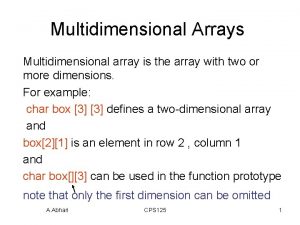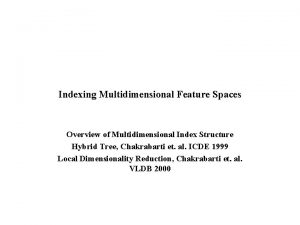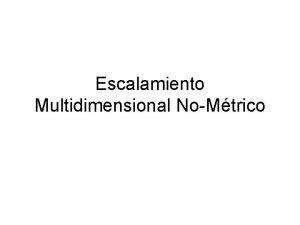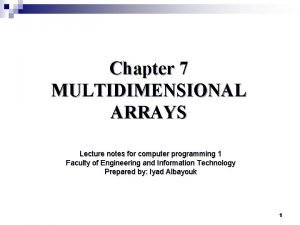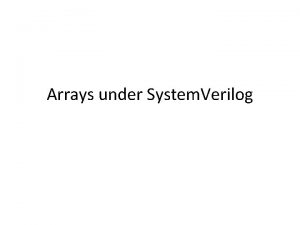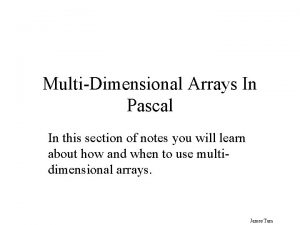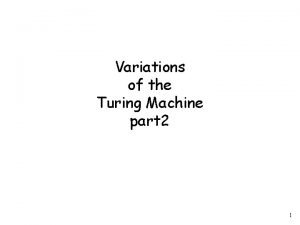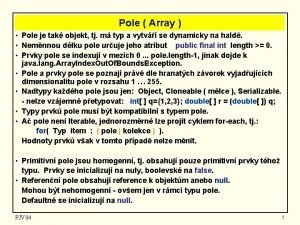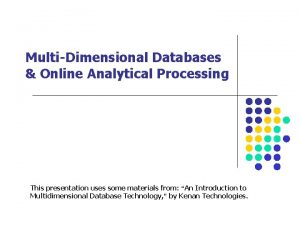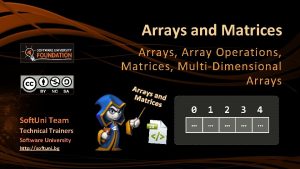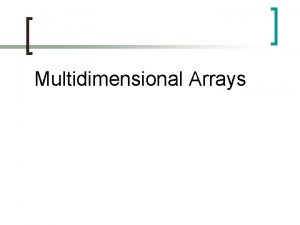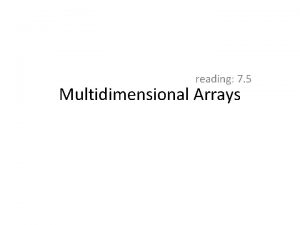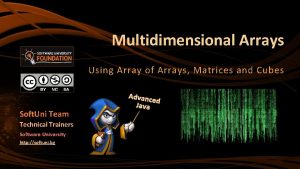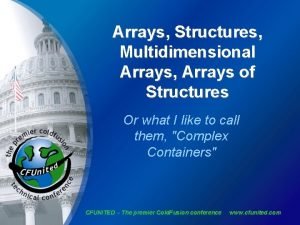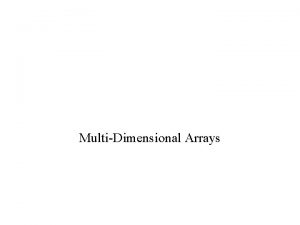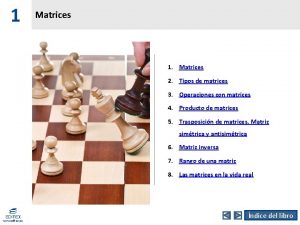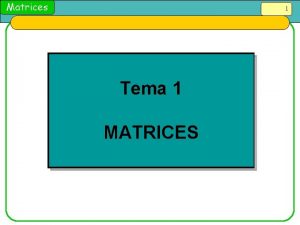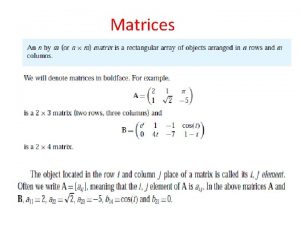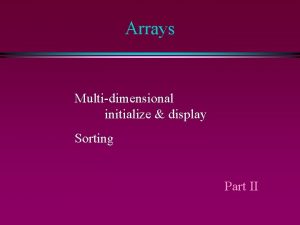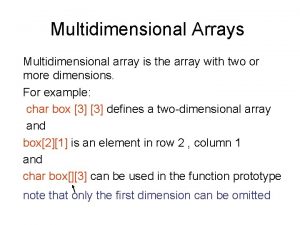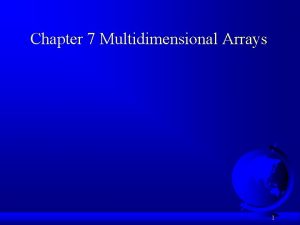MultiDimensional Arrays Matrices Arrays seen so far are






















- Slides: 22

Multi-Dimensional Arrays

Matrices • Arrays seen so far are single dimensional – A linear list of items – One subscript for accessing individual elements • Multidimensional arrays are useful organizations in many applications – values of temperatures at different locations in different times – number of runs in different sessions on different days in a test match – trajectory of a planet in space - time • Matrices – simplest and useful multidimensional arrays – Two dimensions

Two-Dimensional Data Structures • Fortran allows variables that can assume two dimensional array values • Typical values are: 23 14 9 5. 6 78. 9 23. 2 12 67 89 4. 7 0. 7 15. 2 9 5 56 6. 0 98. 2 76. 5 5. 2 23. 0 14. 6 . true. . false. . true. – An integer 3 by 3 matrix: 3 rows and 3 columns of integer values – 4 by 3 real matrix – 3 by 2 logical matrix

Matrix Declaration • Matrix entries can be of different types • No. of rows and columns can be arbitrary • Fortran Declaration defines these two attributes for a matrix variable – Real, Dimension(3, 6): : Sum – Logical, Dimension(23: 100, -2: 5): : flag – integer, Dimension(15: 19, 5): : runs • Accessing an element – Sum(2, 5), flag(56, 0), runs(18, 3) • Two subscripts are needed

Matrix Representation • • Memory is Single-Dimensional Linear representation of matrix elements Row major order: One row after another Column major order: one column after another 15 (assumed representation) 20 • Example: 3 15 56 67 76 56 54 20 54 77 11 45 3 45 86 22 67 77 86 76 11 22

Initialization/Assignment • Using array constructor (column major order) A = ( 2, 3, 4, 5, 6 ) • Explicit nested do loops do I = 1, 5 do J = 1, 8 A(I, J) = I + J end do • Whole row/column assignment do I =1, 5 A(I, : ) = I end do • Initialization can be done at the time of declaration

Assignment • Whole, part or individual array elements can be assigned A =. . . A(: , i) =. . . A(i, j) = … • The rhs should be appropriate type • Lifting of scalar to suitable types may be required • with READ statements read *, ((A(i, j), j = 1, 3), I = 1, 4)

Using matrix variables • Matrix variables can be accessed, individually, in sections or as a whole • Used in expressions on the right hand side of any assignment • Intrinsic functions on base types lifted to matrix types • Eg. Abs, Sin, Cos, Tan, Log, Sqrt can be applied to a matrix variable – Sin(A) is a similar matrix in which each entry is Sin of the corresponding entries in A

Other intrinsic functions • • • LBOUND(A, d) – lower bound of index in the dimension d LBOUND(A) - list of lower bounds UBOUND - upper bound, similar SIZE(A, d) - number of entries in dimension d size(A) - total no. of elements SHAPE(A) - returns the `shape' of A – Extent in a dimension is the no. of entries in that dimension – Shape is an one dimensional array of extents(one entry per dimension)

Transformational Intrinsic Functions • Dot_Product(A, B) - dot product of one dimensional arrays of A and B • MATMUL(A, B) - Matrix multiplication on conformable matrices A and B • RESHAPE(A, B) - B is a one-dimensional shape array – Entries in A are converted into an array of shape B – Column major order used • Example: Suppose A = – Reshape(A, B) = 2 5 6 7 and B = [6, 2] 1328 7589 2 73 688 155279 • Usually used for initializing a matrix from a linear list of elements

Masked Assignment • A more generalized selection is possible using WHERE construct • Suppose, you want to multiply all entries > 0 by 2, and all other entries set to 0 then where (A > 0) A=2*A elsewhere A=0 end where • Note: Reference to an array has many connotations – context dependent

Accessing Matrix variables • When a matrix is accessed, the index values should be valid • illegal values lead to run-time error - Array index exceeding bounds • Compiler optionally inserts code for the check

Generalized Arrays • Multi-dimensional arrays are possible • All array operations, like declaration, initialization and use are similar • Rank of an array is the number of dimensions • One-dimensional array is of rank 1, matrix of rank 2 etc. • Arrays of up to rank 7 are allowed in Fortran

Memory Allocation • Arrays are allocated memory by the compiler • The allocation is static - done at compile time • More and larger arrays, larger the memory requirement • Array use and their size requirements should be done with care – indiscriminate use would result in wastage of memory • Use arrays only when all the data in the arrays are required at the same time in memory

Allocatable Arrays • Allocatable arrays is a solution to memory wastage problem • When the size of an input data set is unknown, better to use the following: real, dimension(), allocatable : : A integer, dimension(: ), allocatable : : B • This is a declaration of an Array A and B of rank 1 and 2 respectively • Only ranks specified, the extent decided dynamically • When A ( and B) initialized, the extents are decided and allocated • This enables avoiding static allocation of conservative estimate of required space

Allocate Construct • Allocatable arrays are allocated memory using explicit instruction: allocate(A(n), i) • This indicates the extent of A is the value of n • This is an external routine that may succeed or fail • Succeeds when the memory allocation is successful • The external procedure sends a value 0 via the parameter i • Typically the size is input by the user which is used in the allocation • Allocated memory can be deallocated using deallocate(A, i) • This succeeds provided the value returned via i is 0

Illustration Linear Systems of Equations • Most commonly occurring problem, the original motivation for matrices • solve a system of n equations in n variables a 11 x 1 + a 12 x 2 +. . . + a 1 nxn = b 1 a 12 x 2 + a 22 x 2 +. . . + a 2 nxn = b 2. . . an 1 x 1 + an 2 x 2 + … + annxn = bn • aij, , bj are all real numbers

Gaussian Elimination • choose any equation and any variable with non zero coefficient ( called pivot) in the equation • eliminate this variable from all other equations by adding a multiple of chosen equation • repeat with remaining equations • solve one equation in one variable • back substitute value of variable to find others • two steps, elimination and back substitution

Program real, dimension(: , : ), allocatable : : a integer : : n, i, j real, dimension(: ), allocatable : : x read *, n ! Number of variables allocate(x(n), stat=i) if ( i /= 0) then print *, "allocation of x failed" stop endif allocate(a(n, n+1), stat=i) if ( i /= 0) then print *, "allocation of array a failed" stop endif do i = 1, n print *, "enter coefficients of equation", i read *, a(i, 1: n+1) end do

do i = 1, n a(i, i: n+1) = a(i, i: n+1)/a(i, i) ! make coefficient of x_i 1. 0 do j = i+1, n a(j, i: n+1) = a(j, i: n+1) - a(i, i: n+1)*a(j, i) end do ! eliminate x_i end do do i = n, 1, -1 x(i) = a(i, n+1) - sum(a(i, i+1: n)*x(i+1: n)) end do ! sum of a null array is 0. 0 print *, "solution is" print *, x(1: n) deallocate(a, x, stat=i) if ( i /= 0) then print *, "deallocation failed" stop endif

Elimination • a(1: n+1, 1: n+1) contains the coefficients, x(1: n) the computed values of variables • assumes a(i, i) /= 0. 0 at every step • true for many special types of matrices • problem if abs(a(i, i)) is too small • elimination needs to be done only once for different right hand sides • only back substitution needs to be done • reduces operations from n 3 to n 2

Pivoting • swap rows and columns to make a(i, i) large • partial pivoting - swap row i with row containing maxval(abs(a(i: n, i))) – what if it is 0. 0? • complete pivoting- swap row and column to make a(i, i) = maxval(abs(a(i: n, i: n))) – what if it is still 0. 0? – this changes order of the variables • gives more accurate results but more time
 Antigentest åre
Antigentest åre Far far away city
Far far away city All of their time and space are foggy slum figure of speech
All of their time and space are foggy slum figure of speech Open handed map awarding the world its world
Open handed map awarding the world its world In a kingdom far far away
In a kingdom far far away Multidimensional reporting
Multidimensional reporting Multidimensional array
Multidimensional array Ssas multidimensional vs tabular
Ssas multidimensional vs tabular Multidimensional or hypervolume niche
Multidimensional or hypervolume niche Multidimensional indexing
Multidimensional indexing Escalamiento multidimensional no métrico
Escalamiento multidimensional no métrico Multidimensional scaling - ppt
Multidimensional scaling - ppt Processing multidimensional array
Processing multidimensional array Multidimensional model of leadership
Multidimensional model of leadership Verilog array indexing
Verilog array indexing Integrative approach to psychopathology
Integrative approach to psychopathology Arrays in pascal
Arrays in pascal Contoh program array 2 dimensi python
Contoh program array 2 dimensi python Multidimensional calm test
Multidimensional calm test Turing machine
Turing machine Marketing multidimensional
Marketing multidimensional Multidimensional array java
Multidimensional array java Multidimensional databases
Multidimensional databases






